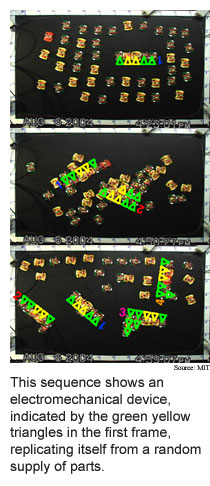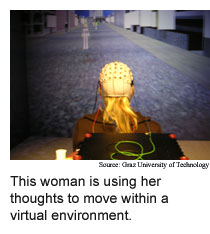
Week
of October 3, 2005
Machine
copies itself like DNA
A device that combines air hockey and DNA marks at least the third
time this year the nascent field of self-replicating machines has seen
a significant advance.
 Researchers from the Massachusetts Institute of Technology have
built a system
that replicates strings of simple electronic devices from random parts
floating on a cushion of air. The system works much like DNA, with a few
rules and a few types of components working to make copies of an initial
example for as long as the supply of parts lasts.
Researchers from the Massachusetts Institute of Technology have
built a system
that replicates strings of simple electronic devices from random parts
floating on a cushion of air. The system works much like DNA, with a few
rules and a few types of components working to make copies of an initial
example for as long as the supply of parts lasts.
The electromechanical parts move around at random and attach or
detatch from each other according to simple communications between neighboring
parts. When a new part latches onto a part that has become part of a copy
of the initial example string, the part in the string checks for a match.
The research could lead to self-replicating machines that build,
repair, and -- reminiscent of childrens transformer toys -- reconfigure
themselves for different tasks or changes in circumstances.
The MIT work is similar to a self-replicating
machine developed at Cornell University, though the Cornell system
uses carefully positioned rather than random parts. The MIT system is
also similar to a simulation
developed by researchers at the Canadian National Research Council and
the University of Waterloo in Canada.
(Self-Replication from Random Parts, Nature, September
29, 2005)
Thoughts wander in VR
Devices that allow for direct brain-computer communications are
advancing on two fronts: devices implanted in the brain, and external
electrodes that pick up the brain's electrical signals. In general the
external devices are safer and cheaper, but the implants provide more
control.
 Typically, users are able to control their brain waves in a way that moves
a cursor up and down and side to side on a computer screen.
Typically, users are able to control their brain waves in a way that moves
a cursor up and down and side to side on a computer screen.
Researchers from Graz University of Technology in Austria, University
College of London in England, Guger Technologies OEG in Austria and the
University of Graz in Austria have expanded the amount of control available
via external electrodes with a means of detecting changes in brain signals
when users imagine
moving their feet and translating the effect into walking motion within
a virtual reality environment.
The system is distinguishes brain signals produced by thinking
about different types of movements, including right hand, left hand, foot
and tongue, and converts the information to control signals. Three test
subjects were able to move forward through an immersive virtual street
scene by imagining walking.
This type of interface promises to enable those who are disabled,
and could eventually give and people whose hands and voices are otherwise
occupied another way to assess computers.
(Walking from Thoughts: Not the Muscles Are Crucial, but the Brain
Waves!, Presence 2005, London, September 21-23, 2005)
In a related development, members of the same research team have
developed a portable brain-computer interface for use in virtual environments.
The battery-powered interface, which includes a diskless Pocket PC, makes
it possible for people to physically move while using brain signal control.
(Integration of a Brain-Computer Interface into Virtual Environments,
Presence 2005, London, September 21-23, 2005)
DNA computing gets chipped
DNA computers can simultaneously check many possible answers to
large problems like determining the best possible traveling salesman's
route. There are billions of possible routes that include just 15 cities,
and there are no mathematical shortcuts for solving this type of problem,
which means they easily overwhelm ordinary computers.
Scientists are increasingly using chip-size devices that control
the flow of DNA suspended in small amounts of fluids to carry out DNA
computing; this is a key requirement for moving DNA computers from the
chemistry lab to the computer science lab and eventually the data center.
Researchers from the University of California at Berkeley have
built a prototype DNA
microfluidic computer processor that brings DNA computing a step closer
to practical use.
The processor contains DNA strands attached to magnetic beads
that are suspended within the device by a magnetic field. Loose DNA strands
that encode every possible answer to a particular problem circulate through
the device, and complementary strands are captured by the suspended strands.
Unattached strands are then rinsed away, and the cycle is repeated until
only strands encoding the correct answer remain.
(An Integrated Microfluidic Processor for Single Nucleotide Polymorphism-Based
DNA Computing, Lab on a Chip, October 2005)
We like people like us -- even fakes
Social science researchers have known for decades that we view
people who mimic our body language more favorably than those who don't.
It turns out that this effect holds true for our interactions with artificial
people as well.
Stanford University researchers tested
subjects who interacted with an artificial man or woman in an immersive
virtual reality computer simulation. The agents either mimicked the subtle
head movements of the test subject after a four second delay or displayed
head movements recorded from a previous session with another subject.
The subjects rated the artificial agents that mimicked their own
head movements as more persuasive and likable than the agents that did
not. Subjects were also more likely to keep agents who mimic their head
moments in view. (Eight out of 69 participants were judged to have consciously
detected the mimicry, and their results were discounted.)
The work could be used to improve characters and avatars in video
games and online environments.
(Digital Chameleons: Automatic Assimilation of Nonverbal Gestures
in the Immersive Virtual Environments, Psychological Science, October
2005)
Bits and pieces: magnetic logic, finding the flu, mapping
electrons
A logic
scheme brings fast, cheap, low-power magnetic computer chips closer
to reality (also see previous
advance); a biochip
that moves and heats fluids identifies a strain of flu virus; scientists
map out how electrons
move through individual molecules.
RSS Feeds: News Blog Books New: TRN's Internet Services TRN's Jobs Center News: Research News Roundup Research Watch blog Features: View from the High Ground Q&A How It Works Buy an ad link |
|
| Advertisements: |
|
Ad links: Clear History
Buy an ad link
|
TRN
Newswire and Headline Feeds for Web sites
|